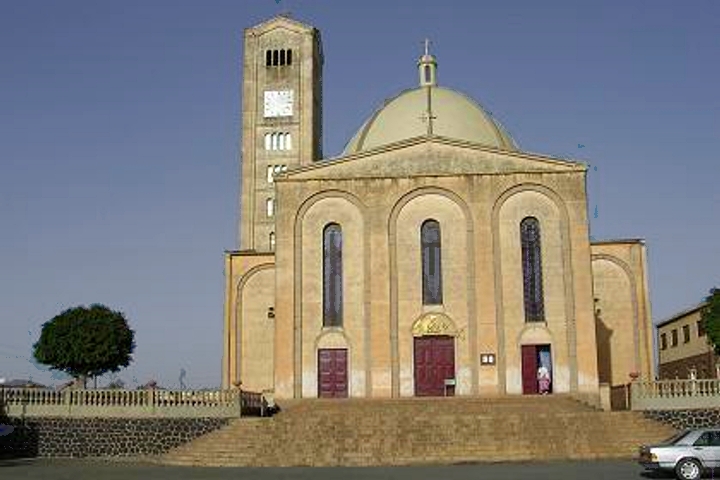|
Geʽez Script
Geʽez ( gez, ግዕዝ, Gəʿəz, ) is a script used as an abugida (alphasyllabary) for several Afro-Asiatic and Nilo-Saharan languages of Ethiopia and Eritrea. It originated as an ''abjad'' (consonant-only alphabet) and was first used to write the Geʽez language, now the liturgical language of the Ethiopian Orthodox Tewahedo Church, the Eritrean Orthodox Tewahedo Church, the Eritrean Catholic Church, the Ethiopian Catholic Church, and Haymanot Judaism of the Beta Israel Jewish community in Ethiopia. In the languages Amharic and Tigrinya language, Tigrinya, the script is often called ' (), meaning “script” or “letter”. Under the Unicode Standard and ISO 15924, it is defined as Ethiopic text. The Geʽez script has been adapted to write other languages, mostly Ethiopian Semitic languages, Ethiosemitic, particularly Amharic in Ethiopia, and Tigrinya in both Eritrea and Ethiopia. It has also been used to write Sebat Bet Gurage language, Sebat Bet and other Gurage languag ... [...More Info...] [...Related Items...] OR: [Wikipedia] [Google] [Baidu] |
Abugida
An abugida (, from Ge'ez language, Ge'ez: ), sometimes known as alphasyllabary, neosyllabary or pseudo-alphabet, is a segmental Writing systems#Segmental writing system, writing system in which consonant-vowel sequences are written as units; each unit is based on a consonant letter, and vowel notation is secondary. This contrasts with a full alphabet, in which vowels have status equal to consonants, and with an abjad, in which vowel marking is absent, Abjad#Impure abjads, partial, or optional (although in less formal contexts, all three types of script may be termed alphabets). The terms also contrast them with a syllabary, in which the symbols cannot be split into separate consonants and vowels. Related concepts were introduced independently in 1948 by James Germain Février (using the term ) and David Diringer (using the term ''semisyllabary''), then in 1959 by Fred Householder (introducing the term ''pseudo-alphabet''). The Ethiopian Semitic languages, Ethiopic term "abugi ... [...More Info...] [...Related Items...] OR: [Wikipedia] [Google] [Baidu] |
Horn Of Africa
The Horn of Africa (HoA), also known as the Somali Peninsula, is a large peninsula and geopolitical region in East Africa.Robert Stock, ''Africa South of the Sahara, Second Edition: A Geographical Interpretation'', (The Guilford Press; 2004), p. 26 Located on the easternmost part of the African mainland, it is the fourth largest peninsula in the world. It is composed of Ethiopia, Eritrea, Somalia and Djibouti; broader definitions also include parts or all of Kenya, Sudan, South Sudan, and Uganda. The term Greater Horn Region (GHR) can additionally include Burundi, Rwanda, and Tanzania. It lies along the southern boundary of the Red Sea and extends hundreds of kilometres into the Guardafui Channel, Gulf of Aden, and Indian Ocean and shares a maritime border with the Arabian Peninsula of Western Asia. Names This peninsula has been known by various names. Ancient Greeks and Romans referred to it as Regio Aromatica or Regio Cinnamonifora due to the aromatic plants or as Regio I ... [...More Info...] [...Related Items...] OR: [Wikipedia] [Google] [Baidu] |
Eritrean Catholic Church
The Eritrean Catholic Church ( la, Ecclesia Catholica Erythraea; ti, ኤርትራዊት ቤተ ክርስቲያን, translit=Chiesa Eritrea) is a metropolitan ''sui iuris'' Eastern particular church headquartered in Asmara, Eritrea. It was established in 2015 by separation of its territory from that of the Ethiopian Catholic Church and the setting up in that territory of a new ''sui iuris'' metropolitan Eastern Catholic Church. It follows the Ge'ez form of the Alexandrian liturgical rite. Its strictly-speaking official name is "The Asmara metropolitan ''sui iuris'' Church". Like the other Eastern Catholic Churches, the Eritrean Catholic Church is in full communion with the Holy See. It holds to the Christological definition taught at the Council of Chalcedon and accepts the universal jurisdiction of the Pope. These points distinguish it from the Eritrean Orthodox Tewahedo Church, which is an Oriental Orthodox church comprising most Christians in the country. Like the Eritrean O ... [...More Info...] [...Related Items...] OR: [Wikipedia] [Google] [Baidu] |
Eritrean Orthodox Tewahedo Church
The Eritrean Orthodox Tewahedo Church ( ti, ቤተ ክርስትያን ተዋህዶ ኤርትራ) is one of the Oriental Orthodox Churches with its headquarters in Asmara, Eritrea. Its autocephaly was recognised by Pope Shenouda III of Alexandria, Pope of the Coptic Orthodox Church, after Eritrea gained its independence from Ethiopia in 1993. History Origins ''Tewahedo'' ( gez, ተዋሕዶ ''täwaḥədo'') is a Ge'ez word meaning "being made one", cognate to Arabic ''tawhid''. According to the ''Catholic Encyclopedia'' (1917 edition) article on the Henoticon: around 500 bishops within the Patriarchates of Alexandria, Antioch and Jerusalem refused to accept the "two natures" doctrine decreed by the Council of Chalcedon in 451, thus separating themselves from the rest of Christianity since that time. This separate Christian communion came to be known as Oriental Orthodoxy. The Oriental Orthodox Churches, which today include the Coptic Orthodox Church of Alexandria, the Armen ... [...More Info...] [...Related Items...] OR: [Wikipedia] [Google] [Baidu] |
Ethiopian Orthodox Tewahedo Church
The Ethiopian Orthodox Tewahedo Church ( am, የኢትዮጵያ ኦርቶዶክስ ተዋሕዶ ቤተ ክርስቲያን, ''Yäityop'ya ortodoks täwahedo bétäkrestyan'') is the largest of the Oriental Orthodox Churches. One of the few Christian churches in sub-Saharan Africa originating before European colonization of the continent, the Ethiopian Orthodox Tewahedo Church dates back to the acceptance of Christianity by the Kingdom of Aksum in 330, and has between 36 million and 49.8 million adherents in Ethiopia. It is a founding member of the World Council of Churches. The Ethiopian Orthodox Tewahedo Church is in Communion (Christian), communion with the other Oriental Orthodox churches (the Eritrean Orthodox Tewahedo Church, the Coptic Orthodox Church of Alexandria, the Malankara Orthodox Syrian Church, the Armenian Apostolic Church, and the Syriac Orthodox Church). The Ethiopian Orthodox Tewahedo Church had been administratively part of the Coptic Orthodox Church of Alexan ... [...More Info...] [...Related Items...] OR: [Wikipedia] [Google] [Baidu] |


